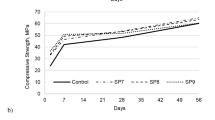Abstract
Biocementation or Microbially Induced Calcium Carbonate Precipitation (MICCP) is a naturally occurring green technique which involves the deposition of calcium carbonate by peculiar action of ureolytic bacteria, which improves the mechanical properties of cementitious materials. These bacteria require a protein source, a vitamin source and a carbon source for optimum growth. Urea and calcium source are necessary to carry out the ureolysis reaction to get CaCO3 depositions which fill the voids within the cementitious materials thereby improving their mechanical properties. To make the process economical, it is necessary to find out optimum concentrations of the various chemicals and ingredients used in the process. Present study aims at finding out the best possible combination of urea and protein source to carry out the MICCP process successfully. There was 22.44% increase in compressive strength and 16.62% reduction in the water absorption of experimental mortar cubes at 28 days of curing with the optimum combination of urea and protein source concentrations.




Similar content being viewed by others
References
Arunachalam K D, Sathyanarayanan K S, Darshan B S and Raja R B 2010 Studies on the characterisation of Biosealant properties of Bacillus sphaericus. Int. J. Eng. Sci. Technol. 2: 270–277
Ramakrishnan V, Panchalan R K and Bang S S 2005 Improvement of concrete durability by bacterial precipitation. In: International conference on fracture
Jonkers H M and Schlangen E 2009 A two component bacteria-based self-healing concrete. Concrete Repair, Rehabilitation and Retrofitting, II: 119–120
Kashyap V N and Radhakrishna 2013 A study on effect of bacteria on cement composites. Int. J. Res. Eng. Technol. 356–360
Vempada S R, Reddy S S P, Rao M V S and Sasikala C 2011 Strength Enhancement of Cement Mortar using Microorganisms—An Experimental Study. Int. J. Earth Sci. Eng. 4: 933–936
Jagadeesha Kumar B G, Prabhakara R and Pushpa H 2013 Effect of Bacterial Calcite Precipitation on Compressive Strength of Mortar Cubes. Int. J. Eng. Adv. Technol. 2: 486–491
Jagadeesha Kumar B G, Prabhakara R and Pushpa H 2013 Bio mineralisation of calcium carbonate by different bacterial strains and their application. Int. J. Adv. Eng. Technol. 6: 202–213
Umar M, Kassim K A, Tiong K and Chiet P 2016 Biological process of soil improvement in civil engineering: A review. J. Rock Mech. Geotech. Eng. 8: 767–774. https://doi.org/10.1016/j.jrmge.2016.02.004
Charpe A U, Latkar M V and Chakrabarti T 2017 Microbially assisted cementation—A biotechnological approach to improve mechanical properties of cement. Constr. Build. Mater. 135: 472–476. https://doi.org/10.1016/j.conbuildmat.2017.01.017
Abo-el-enein S A, Ali A H and Talkhan F N 2013 Application of microbial biocementation to improve the physico-mechanical properties of cement mortar. HBRC J. 9: 36–40. https://doi.org/10.1016/j.hbrcj.2012.10.004
Achal V, Mukerjee A and Reddy M S 2013 Biogenic treatment improves the durability and remediates the cracks of concrete structures. Constr. Build. Mater. 48:1–5. https://doi.org/10.1016/j.conbuildmat.2013.06.061
Achal V, Mukherjee A, Basu P C and Reddy M S 2009 Lactose mother liquor as an alternative nutrient source for microbial concrete production by Sporosarcina pasteurii. J. Ind. Microbiol. Biotechnol. 36: 433–438. https://doi.org/10.1007/s10295-008-0514-7
Choi S, Wu Sand and Chu J 2016 Biocementation for Sand Using an Eggshell as Calcium Source. ASCE 142: 2–5. https://doi.org/10.1061/(asce)gt.1943-5606.0001534
Gomez M G, Dejong J T, Anderson C M, Nelson D C and Graddy C M 2016 Large scale biocementation improvement of sands. Geotechnical and Structural Engineering Congress 941: 941–949
Talaiekhozan A, Keyvanfar A, Shafaghat A, Andalib R, Majid M Z A and Fulazzaky M A 2014 A Review of Self-healing Concrete Research Development. J. Environ. Treat. Tech. 2: 1–11
Bhatty R S, Slinkard A E and Sosulski F W 1976 Chemical composition and protein characterstics of lentils. Can. J. Plant Sci. 794: 787–794
Bureau of Indian Standard IS 383 1970 Specification for Coarse and Fine Aggregate From Natural Sources for Concrete, New Delhi, India
Bureau of Indian Standard IS 12269 2013 Ordinary Portland Cement 53 grade – Specifications
Bureau of Indian Standard IS 4031 (part 6) 1988 Methods of physical tests for hydraulic cement
ASTM C1202 2017 Standard test methods for Electrical Indication of concrete’s Ability to Resist Chloride, 1–8. https://doi.org/10.1520/c1202-12.2
ASTM C140 2012 Standard test methods for sampling and testing concrete masonary units and related units, 1–17. https://doi.org/10.1520/c0140-11a
Bureau of Indian Standard IS 456 2000 Plain and reinforced concrete-code of practice
Bureau of Indian Standard IS 3025 (part 24) 1986 Method of sampling and test (Physical and chemical) for water and wastewater part 24: sulphates
RILEM, Measurement of hardened concrete carbonation depth, CPC 181986, 435–440
Author information
Authors and Affiliations
Corresponding author
Additional information
T. Chakrabarti: Formerly MPCB, Civil Engineering Department, Visvesvaraya National Institute of Technology (VNIT), Nagpur, 440010, India
Rights and permissions
About this article
Cite this article
Bhutange, S.P., Latkar, M.V. & Chakrabarti, T. Role of biocementation to improve mechanical properties of mortar. Sādhanā 44, 50 (2019). https://doi.org/10.1007/s12046-018-1023-7
Received:
Revised:
Accepted:
Published:
DOI: https://doi.org/10.1007/s12046-018-1023-7




